Hey there, fellow hedgehog enthusiasts! Are you ready to dive into the fascinating world of these prickly little creatures? Well, hold on tight because we’ve got 10 surprising facts that’ll blow your mind.
From debunking the myth that they’re rodents to uncovering their unique defense mechanism, we’ll leave no stone unturned. And did you know hedgehogs are incredible swimmers? Yep, they sure are!
So, if you want to become the ultimate hedgehog owner and impress your friends with some mind-boggling trivia, stick around. Let’s get started!
Key Takeaways
- Hedgehogs belong to a separate group of mammals called insectivores
- Hedgehogs have a unique defense mechanism of curling into a ball with spiky quills
- Hedgehogs are naturally nocturnal creatures and sleep for around 18 hours a day
- Hedgehogs can live up to 5 years and require proper weight management and regular vet check-ups
Hedgehogs Are Not Rodents
Did you know that hedgehogs aren’t rodents, but actually belong to a separate group of mammals called insectivores? It’s true! Many people are surprised to learn that their cute and prickly pets are not related to rats or mice. Hedgehogs have unique characteristics and dietary needs that set them apart from the rodent family.
As pets, hedgehogs require special care, including attention to their dental health. Just like humans, hedgehogs can develop dental problems if their teeth are not properly cared for. To keep your hedgehog’s teeth healthy, it’s important to provide them with appropriate chew toys and food options that promote dental wear. Some owners even brush their hedgehog’s teeth using a small toothbrush and pet-safe toothpaste.
Regular veterinary check-ups are also crucial for monitoring your hedgehog’s dental health. A veterinarian experienced in exotic pet care can assess the condition of your hedgehog’s teeth and offer advice on proper dental care techniques.
Hedgehogs Are Nocturnal Creatures
When owning a hedgehog, you’ll notice that they are naturally nocturnal creatures. This means that they are most active during the night and prefer to sleep during the day. Understanding their sleep patterns and nocturnal behavior is crucial for providing them with a comfortable and stimulating environment.
Here are some interesting facts about hedgehog sleep patterns:
- Hedgehogs typically sleep for around 18 hours a day, which might seem excessive to us humans, but it’s completely normal for them.
- During their waking hours, hedgehogs will explore their surroundings, play with toys, and engage in activities that keep them mentally stimulated.
- It’s important to provide your hedgehog with hiding spots or tunnels where they can retreat to during the day when they want to sleep or rest undisturbed.
- Hedgehogs have unique sleeping positions. You may find them curled up into a tight ball with their spines facing outward as a defense mechanism against predators. They may also stretch out fully when feeling safe and relaxed.
Understanding these hedgehog sleep patterns helps us create an environment that meets their needs. Providing plenty of opportunities for mental stimulation and allowing them uninterrupted rest during the day will ensure our little prickly friends thrive in our care.
Hedgehogs Have a Unique Defense Mechanism
As hedgehog owners, we’re familiar with their adorable and prickly appearance. But did you know that those spiky quills serve as a crucial defense mechanism for these little creatures?
When threatened, hedgehogs have the incredible ability to curl into a ball, using their quills as an impenetrable shield. This unique adaptation allows them to protect themselves from predators and ensures their survival in the wild.
Spiky Quills Protect Hedgehogs
You’ll be amazed by how hedgehogs’ spiky quills provide them with ultimate protection. These fascinating creatures have a unique defense mechanism that revolves around their quill anatomy and requires proper hedgehog quill care. Here’s what you need to know:
- Quill Anatomy:
- Hedgehogs have approximately 5,000 to 7,000 quills on their backs.
- Each quill is made of keratin, the same material as our hair and nails.
- The base of the quill is attached to a muscle, allowing the hedgehog to control its movement.
- Quill Care:
- Regular bathing helps keep the quills clean and prevents mites or infections.
- Trimming the tips of the longer quills can prevent accidental injuries for both you and your pet.
Understanding hedgehog quill anatomy and providing proper care will ensure your little spiky friend remains protected and healthy.
Curling Into a Ball
Hedgehogs can curl into a ball to protect themselves from predators. This unique adaptation allows them to create a spiky fortress that is difficult for any potential threat to penetrate.
But did you know that hedgehogs also have some surprising swimming abilities? While they may not be natural swimmers, they are surprisingly good at staying afloat and even propelling themselves through water using their strong back legs. It’s quite fascinating to watch these small creatures maneuver in the water with such ease.
In addition to their swimming adaptations, hedgehogs are also social animals that enjoy interacting with others of their kind. They communicate through a variety of sounds and behaviors, including snuffling, grunting, and even purring when they feel content and safe. These social interactions are important for their well-being and sense of belonging within their community.
Hedgehogs Are Excellent Swimmers
When it comes to hedgehogs, most people don’t immediately think of them as proficient swimmers. However, these spiky creatures have some surprising swimming abilities that are worth exploring.
In this discussion, we will delve into the adaptations that hedgehogs have developed for aquatic life and how they use their unique skills to navigate through water with ease.
Hedgehog Swimming Abilities
If you’re considering letting your hedgehog swim, be aware that they are not natural swimmers and may struggle in the water. While some hedgehogs may show interest in water and even enjoy a quick dip, it’s important to take proper precautions to ensure their safety.
Here are some key points to consider:
- Hedgehog swimming techniques:
- Start by introducing your hedgehog to shallow water, like a small basin or sink, with supervision.
- Gradually increase the depth of the water as your hedgehog becomes more comfortable.
- Importance of water in a hedgehog’s habitat:
- In the wild, hedgehogs encounter natural bodies of water such as streams or puddles.
- Adequate hydration is essential for their overall health and well-being.
Adaptations for Aquatic Life
Now that we know about hedgehogs’ surprising swimming abilities, let’s dive deeper into their adaptations for aquatic life.
Contrary to popular belief, some hedgehog species are actually water-loving creatures. These amazing animals have developed several adaptations to thrive in the watery world.
Firstly, their quills play a crucial role in keeping them buoyant. The hollow quills trap air when they enter the water, making them float effortlessly. Additionally, their fur is designed to repel water and keep them dry.
Moreover, hedgehogs have webbed feet that aid in swimming efficiently. These specialized feet allow them to paddle through water with ease and control their movements underwater.
Lastly, hedgehogs possess a keen sense of smell that helps them locate food sources underwater. Their ability to hunt and catch aquatic prey is truly remarkable.
In conclusion, these aquatic adaptations showcase the incredible versatility of hedgehogs and highlight their ability to adapt to various environments.
Water-loving hedgehogs are truly fascinating creatures!
Hedgehogs Have a Varied Diet
To keep your hedgehog healthy, you should know that they have a varied diet. Hedgehogs are omnivores, meaning they eat both plant and animal matter. Here’s what you need to know about their feeding habits and nutritional needs:
- Plant-based foods: Hedgehogs enjoy a variety of fruits and vegetables. Some favorites include apples, bananas, carrots, and leafy greens like spinach or kale. These provide essential vitamins and minerals.
- Protein sources: Hedgehogs need high-quality protein in their diet. In the wild, they would eat insects like crickets or mealworms. As pets, you can feed them commercially available hedgehog food that contains the necessary nutrients.
- Insects: Offer live or freeze-dried insects as treats for your hedgehog. Mealworms and crickets are readily available at pet stores.
- Meat: Cooked lean meats such as chicken or turkey can also be given occasionally to supplement their protein intake.
It’s important to remember that hedgehogs have small stomachs, so portions should be controlled to prevent obesity. Always provide fresh water for hydration.
Understanding your hedgehog’s feeding habits and meeting their nutritional needs is crucial for keeping them healthy and happy companions in your home!
Hedgehogs Are Solitary Animals
When it comes to social behaviors in hedgehogs, there are some surprising facts that every owner should know. While they may seem cute and cuddly, it’s important to understand that hedgehogs are actually solitary animals by nature.
This means that they prefer to spend most of their time alone and value their alone time greatly.
Social Behaviors in Hedgehogs
Did you know that hedgehogs are actually solitary creatures and prefer to live alone? However, this doesn’t mean that they don’t engage in any social behaviors. Hedgehog communication is an important aspect of their lives, allowing them to establish territories and warn others of potential danger. They use a variety of vocalizations, such as snorts and hisses, as well as physical cues like quill raising and stomping their feet.
When it comes to bonding with humans, hedgehogs can form strong connections with their owners. Through regular handling and interaction, these adorable creatures can become quite affectionate and start recognizing their human’s scent and voice. They might even curl up in your hand or lap during cuddle time!
To help foster a sense of belonging for your hedgehog, provide them with plenty of enrichment activities like hiding spots, tunnels, and toys. Remember to respect their need for alone time though – just because they’re social animals doesn’t mean they want constant attention!
Importance of Alone Time
Although hedgehogs are social animals, they still require alone time to recharge and relax. Just like humans, hedgehogs benefit from having some quiet time to themselves. Alone time allows them to destress and rejuvenate, helping them maintain a healthy balance in their lives.
Creating a comfortable alone space for your hedgehog is essential to ensuring they can fully enjoy their solitude. Providing a cozy hiding spot, such as a small igloo or nest box, will give them the privacy they need. Adding soft bedding material like fleece or shredded paper will make the space even more inviting.
It’s also important to place the alone space in a quiet area away from loud noises and disturbances. By giving your hedgehog the opportunity for regular alone time in a comfortable environment, you are promoting their overall well-being and happiness.
Hedgehogs Have a Long Lifespan
You’ll be amazed to learn that hedgehogs can live for up to 5 years! Hedgehogs may seem like small and delicate creatures, but they have a surprising longevity when taken care of properly. Here are some fascinating facts about their lifespan:
- Genetics: A hedgehog’s lifespan is influenced by genetics. Some individuals may live longer than others due to their genetic makeup.
- Breeding: Responsible breeding practices can help ensure healthier offspring with longer lifespans.
- Healthy Diet: Providing a balanced diet rich in protein and essential nutrients contributes to a hedgehog’s overall health and lifespan.
- Environmental Factors: The environment in which a hedgehog lives also plays a crucial role in its longevity.
- Temperature Control: Hedgehogs are sensitive to extreme temperatures, so it’s important to provide them with proper heating or cooling options.
- Stress Management: Minimizing stressors such as loud noises or sudden changes can help increase a hedgehog’s lifespan.
Taking these factors into consideration, you can create an ideal living environment for your pet hedgehog and promote their long and healthy life. Remember, caring for these adorable creatures requires commitment and dedication, but the rewards of watching them thrive make it all worthwhile.
Hedgehogs Are Prone to Obesity
To prevent obesity in your hedgehog, it’s important to monitor their diet and ensure they are not overeating. Hedgehogs, like many other small animals, are prone to gaining weight if not properly managed. Obesity can lead to serious health issues for your pet, such as heart disease and joint problems.
One way to help manage their weight is by incorporating regular exercise into their routine. Hedgehogs may seem slow-moving and lazy, but they actually require physical activity to stay healthy. Providing them with a suitable exercise routine is essential. You can start by letting them explore a safe and secure space outside of their cage for at least 30 minutes each day. This will give them the opportunity to move around, stretch their legs, and burn off excess calories.
In addition to free-roaming time, you can also introduce interactive toys that encourage movement and mental stimulation. Hedgehogs enjoy playing with tunnels, running wheels, and even simple obstacle courses made from cardboard boxes or tubes.
Remember that while exercise is important for weight management, monitoring their diet is equally crucial. Avoid feeding your hedgehog excessive amounts of high-fat foods or treats. Stick to a balanced diet consisting mainly of high-quality hedgehog food supplemented with occasional fresh fruits and vegetables.
Hedgehogs Require Specific Temperature and Humidity Levels
Maintaining proper temperature and humidity levels is vital for the health and well-being of your hedgehog. As owners, it’s our responsibility to create an environment that mimics their natural habitat. Here are some important points to consider:
- Temperature regulation:
- Hedgehogs prefer a temperature range between 72°F and 80°F (22°C – 27°C).
- Provide a heating source such as a ceramic heat emitter or heat pad to maintain a consistent temperature.
- Humidity control:
- Hedgehogs thrive in environments with humidity levels of around 40% to 60%.
- Use a hygrometer to monitor the humidity in their enclosure regularly.
Proper temperature and humidity levels are crucial for various reasons. Firstly, maintaining the right temperature ensures that your hedgehog stays comfortable and avoids health issues like hibernation attempts. Secondly, appropriate humidity levels help prevent respiratory problems caused by dry air or excessive moisture.
To achieve optimal conditions, you can place thermometers and hygrometers near your hedgehog’s living area. Additionally, provide them with hiding spots where they can regulate their body temperature naturally.
Hedgehogs Can Make Great Pets With Proper Care and Handling
With proper care and handling, hedgehogs can become wonderful companions for anyone seeking a unique and enjoyable pet. Hedgehog bonding is an essential aspect of building a strong relationship with your prickly friend. Spending time together, such as gentle handling or simply sitting beside their enclosure while talking softly, helps them become familiar with your presence. Slowly introducing new scents by placing an item you’ve worn in their habitat can also aid in the bonding process.
In addition to bonding, hedgehog enrichment plays a crucial role in keeping these pets happy and stimulated. Providing them with a variety of toys such as tunnels, balls, and puzzle feeders encourages physical activity and mental stimulation. Hedgehogs are natural explorers, so creating a safe space where they can freely roam outside of their enclosure is beneficial for their overall well-being.
To ensure their health and happiness, it’s important to maintain a balanced diet consisting of high-quality commercial hedgehog food supplemented with insects like mealworms or crickets. Regular vet check-ups are also necessary to monitor their weight and address any potential health issues.
Frequently Asked Questions
How Do Hedgehogs Defend Themselves From Predators?
Hedgehogs defend themselves from predators by curling into a tight ball, with their sharp spines facing outward. They also make loud hissing and clicking noises to scare away threats. Their unique defense mechanisms help keep them safe in the wild.
Can Hedgehogs Be Trained to Swim?
Yes, hedgehogs can be trained to swim. Like graceful otters gliding through the water, they can learn swimming techniques. However, it’s important to take safety precautions and provide a suitable environment for their aquatic adventures.
What Should I Feed My Hedgehog to Ensure a Healthy Diet?
To ensure a healthy diet for our hedgehog, we need to consider their nutritional needs. It’s important to feed them a balanced diet that includes high-quality commercial hedgehog food, supplemented with insects and occasional fruits/vegetables.
Do Hedgehogs Get Lonely if Kept Alone?
Yes, hedgehogs can get lonely if kept alone. They are social creatures and enjoy companionship. They can bond with humans but also benefit from interaction with other hedgehogs for a sense of belonging and well-being.
What Are the Ideal Temperature and Humidity Levels for Hedgehog Habitats?
The ideal temperature range for hedgehog habitats is between 72-80 degrees Fahrenheit, with a humidity level of 40-60%. It’s important to provide suitable bedding materials like fleece or paper-based options to ensure their comfort and well-being.
Conclusion
In conclusion, owning a hedgehog can be quite a fascinating experience. Who knew these prickly creatures were not rodents? And did you know they have their own unique defense mechanism? It’s like having a built-in superhero!
Plus, hedgehogs are excellent swimmers, so don’t be surprised if you find them doing laps in your bathtub. Just make sure to keep an eye on their diet and prevent them from becoming obese, because no one wants a pudgy hedgehog rolling around.
With the right care and handling, these little spiky fellows can make great pets. So go ahead and embrace the quills!
















Leave a Reply
View Comments